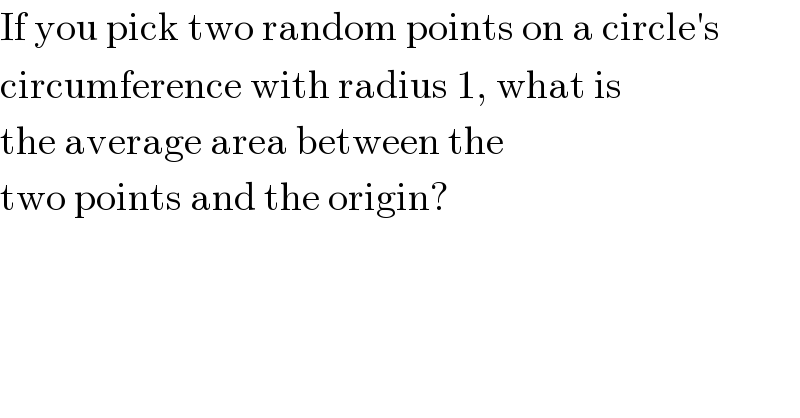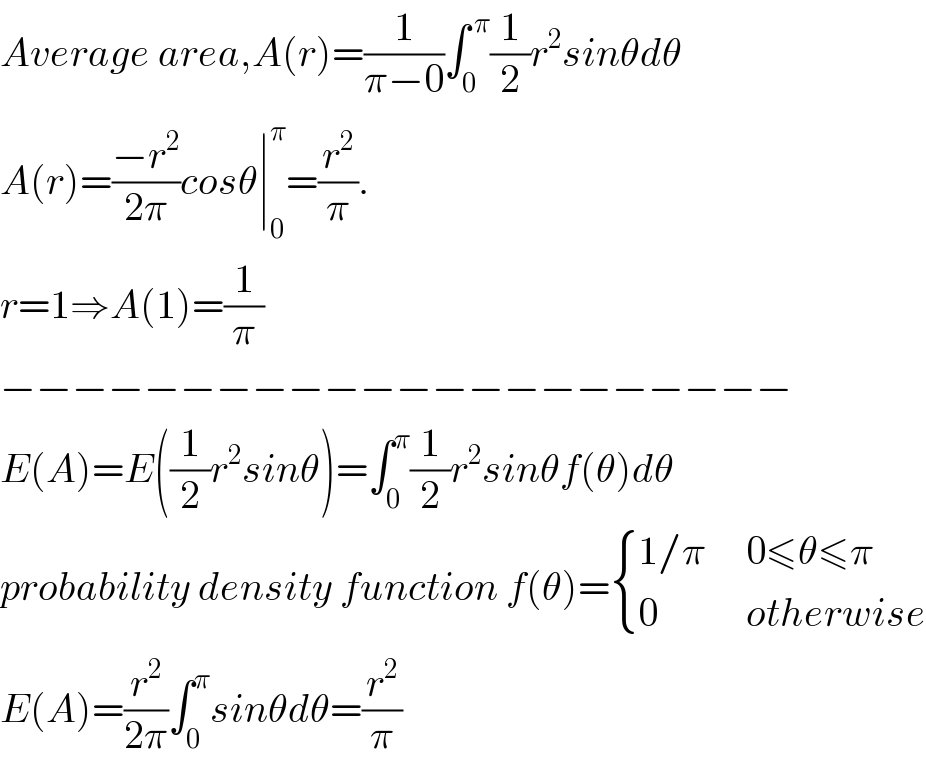
Question Number 6672 by FilupSmith last updated on 11/Jul/16

$$\mathrm{If}\:\mathrm{you}\:\mathrm{pick}\:\mathrm{two}\:\mathrm{random}\:\mathrm{points}\:\mathrm{on}\:\mathrm{a}\:\mathrm{circle}'\mathrm{s} \\ $$$$\mathrm{circumference}\:\mathrm{with}\:\mathrm{radius}\:\mathrm{1},\:\mathrm{what}\:\mathrm{is} \\ $$$$\mathrm{the}\:\mathrm{average}\:\mathrm{area}\:\mathrm{between}\:\mathrm{the} \\ $$$$\mathrm{two}\:\mathrm{points}\:\mathrm{and}\:\mathrm{the}\:\mathrm{origin}? \\ $$
Commented by Yozzii last updated on 11/Jul/16

$${Average}\:{area},{A}\left({r}\right)=\frac{\mathrm{1}}{\pi−\mathrm{0}}\int_{\mathrm{0}} ^{\:\pi} \frac{\mathrm{1}}{\mathrm{2}}{r}^{\mathrm{2}} {sin}\theta{d}\theta \\ $$$${A}\left({r}\right)=\frac{−{r}^{\mathrm{2}} }{\mathrm{2}\pi}{cos}\theta\mid_{\mathrm{0}} ^{\pi} =\frac{{r}^{\mathrm{2}} }{\pi}. \\ $$$${r}=\mathrm{1}\Rightarrow{A}\left(\mathrm{1}\right)=\frac{\mathrm{1}}{\pi} \\ $$$$−−−−−−−−−−−−−−−−−−−−−− \\ $$$${E}\left({A}\right)={E}\left(\frac{\mathrm{1}}{\mathrm{2}}{r}^{\mathrm{2}} {sin}\theta\right)=\int_{\mathrm{0}} ^{\pi} \frac{\mathrm{1}}{\mathrm{2}}{r}^{\mathrm{2}} {sin}\theta{f}\left(\theta\right){d}\theta \\ $$$${probability}\:{density}\:{function}\:{f}\left(\theta\right)=\begin{cases}{\mathrm{1}/\pi\:\:\:\:\:\mathrm{0}\leqslant\theta\leqslant\pi}\\{\mathrm{0}\:\:\:\:\:\:\:\:\:\:\:{otherwise}}\end{cases} \\ $$$${E}\left({A}\right)=\frac{{r}^{\mathrm{2}} }{\mathrm{2}\pi}\int_{\mathrm{0}} ^{\pi} {sin}\theta{d}\theta=\frac{{r}^{\mathrm{2}} }{\pi} \\ $$
Commented by FilupSmith last updated on 11/Jul/16

$$\mathrm{why}\:\mathrm{is}\:\mathrm{the}\:\mathrm{integral}\:\mathrm{between}\:\mathrm{0}\:\mathrm{and}\:\pi \\ $$$$\mathrm{rather}\:\mathrm{than}\:\mathrm{0}\:\mathrm{and}\:\mathrm{2}\pi? \\ $$
Commented by Yozzii last updated on 11/Jul/16

$${I}\:{let}\:{the}\:{origin}\:{be}\:{the}\:{centre}\:{of}\:{the} \\ $$$${circle}\:{so}\:{that}\:\mathrm{0}\leqslant\angle{P}_{\mathrm{1}} {OP}_{\mathrm{2}} \leqslant\pi\:{as}\:{is} \\ $$$${expected}\:{of}\:{a}\:{triangle}. \\ $$
Commented by FilupSmith last updated on 11/Jul/16

$${I}\:{understand}!\:\boldsymbol{{Thanks}} \\ $$
